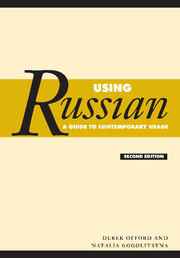Book contents
- Frontmatter
- Contents
- Preface to the first edition
- Preface to the second edition
- Acknowledgements
- Sources
- Note on transcription, stress marks and transliteration
- Glossary of linguistic terms
- List of abbreviations
- 1 Varieties of language and register
- 2 Passages illustrating register
- 3 Problems of meaning: Russian words
- 4 Problems of translation from English into Russian
- 5 Vocabulary and idiom
- 6 Language and everyday life
- 7 Verbal etiquette
- 8 Word-formation
- 9 Inflection
- 10 Prepositions
- 11 Syntax
- 12 Stress
- Index of Russian words, phrases and affixes
- General index
9 - Inflection
Published online by Cambridge University Press: 05 June 2012
- Frontmatter
- Contents
- Preface to the first edition
- Preface to the second edition
- Acknowledgements
- Sources
- Note on transcription, stress marks and transliteration
- Glossary of linguistic terms
- List of abbreviations
- 1 Varieties of language and register
- 2 Passages illustrating register
- 3 Problems of meaning: Russian words
- 4 Problems of translation from English into Russian
- 5 Vocabulary and idiom
- 6 Language and everyday life
- 7 Verbal etiquette
- 8 Word-formation
- 9 Inflection
- 10 Prepositions
- 11 Syntax
- 12 Stress
- Index of Russian words, phrases and affixes
- General index
Summary
Russian is a highly inflected language. Meaning is much more dependent on the ending of words and less dependent on word order than is the case in English. Without a thorough knowledge of the many flexions used on Russian nouns, pronouns, adjectives, numerals and verbs it is impossible not only to speak and write Russian correctly but even to arrive at an accurate understanding of what one hears or reads.
However, the difficulty of learning the numerous flexions is not so great as seems at first to be the case if the learner keeps in mind the distinction between hard and soft consonants and the spelling rules listed in 8.2.1 and 8.2.4 and takes the trouble to study the basic declensional and conjugational patterns set out in this chapter.
Declension of the noun
The Russian declensional system has six cases and distinguishes between singular and plural. The six cases are nominative, accusative, genitive, dative, instrumental and prepositional. There is a very small number of relics of the vocative case and dual number (see Glossary). Some nouns exist only in a plural form (e.g. сýтки), at least in certain meanings (e.g. часí, clock; 3.6.1). Some nouns borrowed from other languages are indeclinable (9.1.12).
- Type
- Chapter
- Information
- Using RussianA Guide to Contemporary Usage, pp. 288 - 332Publisher: Cambridge University PressPrint publication year: 2005



